Brick Veneer
How to use thin brick or cultured brick to get a traditional look
-
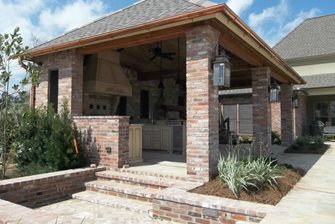 This outdoor kitchen in Louisiana demonstrates how pervasive brick is to the regional architectural vernacular.
This outdoor kitchen in Louisiana demonstrates how pervasive brick is to the regional architectural vernacular.
-
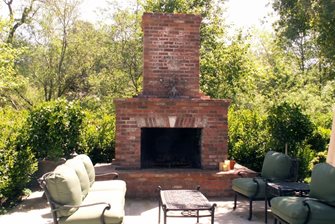 Whether applied to prefabricated units or to a standard block and mortar construction, brick allows patterns and details to bring interest at close range.
Whether applied to prefabricated units or to a standard block and mortar construction, brick allows patterns and details to bring interest at close range.
-
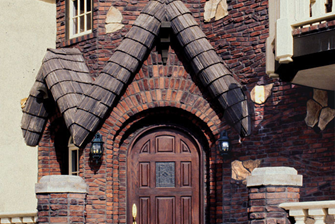 Coronado Stone, a leading producer of manufactured stone veneers produces an excellent range of unique brick veneers as well.
Coronado Stone, a leading producer of manufactured stone veneers produces an excellent range of unique brick veneers as well.
-
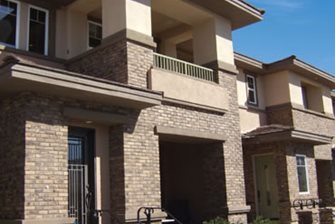 The soft color of this Coronado Stone brick veneer demonstrates how these same products can be used on building walls as well as exterior landscape structures.
The soft color of this Coronado Stone brick veneer demonstrates how these same products can be used on building walls as well as exterior landscape structures.
-
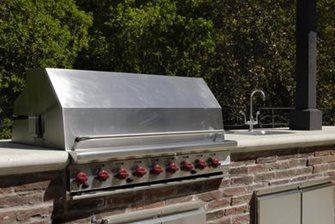 Eldorado Stone offers these units in pre-grouted panels so there are whole steps eliminated from the installation process of laying individual bricks.
Eldorado Stone offers these units in pre-grouted panels so there are whole steps eliminated from the installation process of laying individual bricks.
- 1
- 2
- 3
- 4
- 5
Brick has been the standard of excellence in the South and parts of the Northeast where this material has been part of the architectural vernacular since colonial times. For many, no other material will suffice. Unlike stone veneer which is highly variable, brick is a more traditional unchanging look. There has been innovation, however. The introduction of thinner light tone Roman brick suits Mediterranean style landscapes. For Craftsman bungalows, dark irregular clinker style brick is particularly popular in the far west.
The use of brick in outdoor hardscape was revolutionized by the advent of thin brick in the 1970s. Because brick is and has always been a manufactured product, it was a simple extension of existing companies to provide a thinner version to apply to exterior masonry. Like all veneers, they are lighter in weight than their predecessors, which opens opportunities for use where the substrate is not strong enough for whole brick. However, in exterior applications, thin brick and its full sized counterpart are often used together, one to face a wall and the other to create a well sized matched cap.
Traditional brick manufacturers produce their thin brick the same way they do standard brick which include the colors that are limited to clay products as well. These are all clay that is kiln fired and feature the same surface colors and textures found throughout the brick marketplace. Many of these can be treated to resemble clinkers, or to appear used with remnants of paint, but only quality product will be sufficiently varied to truly resemble the true brick.
Thin brick is less expensive, more lightweight and easier to install. At a third the size of a standard brick, it is also much more affordably shipped. There is particular emphasis placed on waterproofing this material due to the shallow nature of the grout joints compared to that of full sized brick.
Cultured BrickCompanies that produce cultured stone typically include a line of manufactured brick veneer, often on panels that speed up the installation process considerably. These products have been widely accepted by the architectural industry where they are used as building siding on large scale commercial and residential applications. If such materials stand up to this use, they will do so in the landscape as well except for one factor. Like manufactured stone, this cultured brick is not suited to use around pools, spas and fountains, and wherever it will come in contact with chemically treated water.
These companies have the ability to reproduce all colors and patterns of real brick, but may also go beyond this in color. With no limits to what they can achieve, uniquely detailed surface colors and authentic textures that lend a more aged, used look can make this material preferable to new clay product. This may be the only option where Roman brick or clinkers aren't available in thin brick veneer.
|
Contributing Author: Maureen Gilmer, contributing writer for Landscaping Network, author and syndicated columnist |



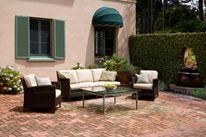 Brick Paving
Brick Paving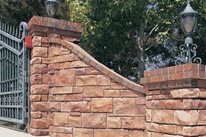 Stone Veneer
Stone Veneer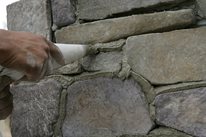 Veneer Installation
Veneer Installation

